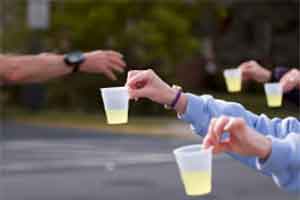Doctors Warn Hikers, Other Endurance Athletes, and Medical Personnel About the Risks of Water Intoxication
Knowing the warning signs and responding with the right treatment can save lives, according to a new report published in Wilderness & Environmental Medicine
 While emphasis is often placed on keeping athletes and outdoor enthusiasts properly hydrated, too much water can be just as dangerous. Exercise-associated hyponatremia (EAH), also known as water intoxication, results in an extreme, and potentially fatal, sodium imbalance. In the latest issue of Wilderness & Environmental Medicine, investigators detail the case of a hiker who died as an illustration of the potential danger of endurance exercise and excessive water intake lowering serum sodium to a dangerous level. There have been several deaths from EAH associated with various sports. This is one of few reported fatalities due to EAH in a wilderness setting.
While emphasis is often placed on keeping athletes and outdoor enthusiasts properly hydrated, too much water can be just as dangerous. Exercise-associated hyponatremia (EAH), also known as water intoxication, results in an extreme, and potentially fatal, sodium imbalance. In the latest issue of Wilderness & Environmental Medicine, investigators detail the case of a hiker who died as an illustration of the potential danger of endurance exercise and excessive water intake lowering serum sodium to a dangerous level. There have been several deaths from EAH associated with various sports. This is one of few reported fatalities due to EAH in a wilderness setting.
The study details the death of a 47-year-old female hiker who passed out after a 10 km hike on the South Kaibab Trail in Grand Canyon National Park in 2008. Over a five-hour period, the woman consumed a large amount of water but ate very little food. She collapsed approximately an hour after finishing the hike. Despite the efforts of emergency medical personnel, the patient was pronounced dead 19 hours later from cerebral edema brought on by water intoxication.
As outdoor endurance recreation grows in popularity, so does the risk of EAH. Early symptoms of EAH often mimic dehydration and include nausea, vomiting, malaise, and headache. If left untreated, the condition can lead to an altered mental status, seizures, and death. Unfortunately, many practitioners have difficulty recognizing the condition and treating it appropriately.
“EAH results from overhydration, and avoiding additional fluid overload is critically important in treatment,” explained co-investigator Martin D. Hoffman, MD, Department of Physical Medicine and Rehabilitation, Department of Veterans Affairs, Northern California Health Care System, University of California Davis Medical Center, Sacramento, CA, and Editor-in-Chief of Wilderness & Environmental Medicine. “Because dehydration is often a reflex diagnosis for a symptomatic exerciser in a hot environment, the usual treatment of oral or IV isotonic or hypotonic fluids needs to be resisted if there is a strong likelihood that the underlying condition is EAH.”
Investigators hope that this study can help doctors and other medical personnel identify and properly treat EAH. The case highlights several important factors that may be helpful in the treatment of EAH patients. First, at the time of the incident in 2008, pre-hospital serum sodium testing was not conducted because first responders were not equipped with point-of-care blood analyzers, which may have alerted staff about possible water intoxication.
Second, when testing was available at the hospital, the patient’s serum sodium concentration was not considered extremely low at 127 mmol/L. “The admission serum sodium concentration of 127 mmol/L in the present EAH fatality case should serve as further evidence that treatment should be based on the extent of symptoms rather than the absolute sodium concentration,” commented co-investigator Thomas M. Myers, MD, Branch of Emergency Services, Grand Canyon National Park, Grand Canyon, AZ.
Third, the patient’s initial treatment included the administration of isotonic fluids, which may have adversely affected her outcome. “Emergency medical practitioners should be aware of current management guidelines for EAH because persistent common treatment with high volumes of isotonic fluids has been associated with delayed recovery, and has likely contributed to deaths,” noted Dr. Hoffman.
Current guidelines include fluid restriction and the use of hypertonic saline to quickly reverse the effects of EAH. “Rapid reversal of hyponatremia when occurring acutely in EAH has not been associated with any known cases of central pontine myelinolysis,” added Dr. Myers. “Early recognition and treatment of symptomatic EAH with hypertonic saline has been demonstrated to be safe and effective, and is now the mainstay of current management guidelines.”
Because of this incident and difficulties distinguishing EAH from dehydration in the field, emergency workers in Grand Canyon National Park now have access to point-of-care serum testing, as well as the ability to administer hypertonic saline. “We hope that this report of a fatal outcome from EAH and the discussion about the importance of rapid recognition and treatment will stimulate others to develop more appropriate systems for the recognition and treatment of EAH,” concluded Dr. Hoffman.
Source: Elsevier
Full bibliographic information:
“Hiker Fatality From Severe Hyponatremia in Grand Canyon National Park,” by Thomas M. Myers, MD, and Martin D. Hoffman, MD (DOI: ). It appears in Wilderness & Environmental Medicine, Volume 26, Issue 3 (September 2015) published by Elsevier.

